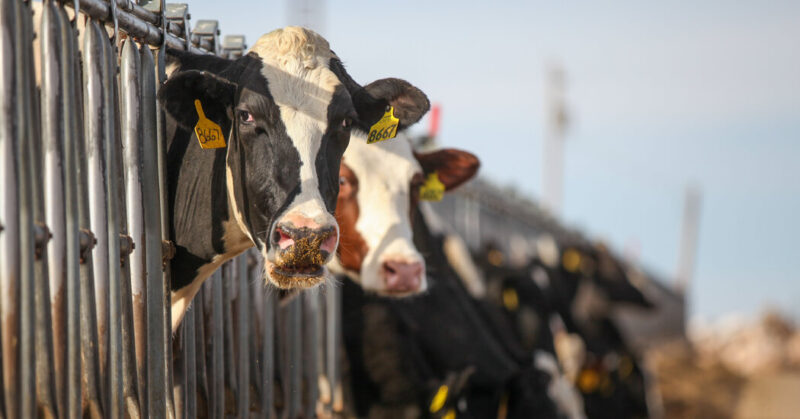A form of avian influenza that is highly fatal in birds has been confirmed in U.S. dairy cattle in Texas and Kansas, the Department of Agriculture announced on Monday.
It is the first time that cows infected with the virus have been identified.
The cows appear to have been infected by wild birds, and dead birds were reported on some farms, the agency said. The Texas Animal Health Commission confirmed that the influenza subtype known as H5N1 has been identified and said that the virus resembled the version that has been spreading in birds across the nation.
The results were announced after multiple federal and state agencies began investigating reports of sick cows in Texas, Kansas and New Mexico. The illness has primarily affected older cows, causing symptoms that include reduced appetite, fever and a sudden drop in milk production. So far, the U.S.D.A. said, there had been few or no reports of deaths in the affected herds.
In several cases, the virus was detected in unpasteurized samples of milk collected from sick cows. Pasteurization should inactivate the flu virus, experts said, and officials stressed that the milk supply was safe.
“At this stage, there is no concern about the safety of the commercial milk supply or that this circumstance poses a risk to consumer health,” the agency said in a statement.
Outside experts agreed. “It has only been found in milk that is grossly abnormal,” said Dr. Jim Lowe, a veterinarian and influenza researcher at the College of Veterinary Medicine at the University of Illinois at Urbana-Champaign.
In those cases, the milk was described as thick and syrupy, he said, and was discarded. The agency said that dairies are required to divert or destroy milk from sick animals.
The cattle infections come on the heels of the nation’s first detection of highly pathogenic bird flu in goats, which was announced by Minnesota officials last week.
So far, the flu samples from sick cows have not contained genetic mutations that are known to make the virus more likely to infect humans, the agriculture agency said, adding that the risk to the general public remained low.
“There’s still no cause to panic,” said Stacey L. Schultz-Cherry, a virologist and influenza expert at St. Jude Children’s Research Hospital. “It just looks like it’s another spillover event due to contact with diseased wild birds.”
Still, she noted, cows were not thought to be among the species that were particularly susceptible to avian influenza, and the cases were another worrisome turn in a global bird flu outbreak that has devastated wild bird populations over the last few years.
The outbreak has been caused by a new form of bird flu virus, known as H5N1, that emerged in Europe in 2020. Wild birds can spread the virus, through their feces and oral secretions, to farmed poultry and other animals. Outbreaks often flare up in the spring and summer, when migrating birds are on the move.
Although avian influenza viruses are adapted to spread primarily among birds, the new version of H5N1 has become so widespread in wild birds that it has also repeatedly spread to mammals, especially scavenging species, such as foxes, that might feed on infected birds.
Infected wild birds could transmit the virus to cows by contaminating their food or water, said Dr. Joe Armstrong, a veterinarian and cattle production expert at the University of Minnesota Extension. “You get onto a farm, especially during the migratory season, and you’ve got geese and ducks looking for feed just like everyone else,” he said. “To me that’s the most likely route.”
But it is also possible that free-ranging cats, which are not uncommon on farms and are known to be susceptible to the virus, could be involved in spreading the pathogen, he said.
Dr. Armstrong also cautioned that it was too soon to conclude that avian influenza was the primary cause of disease in all of the sick cows that have been reported.
Infections of mammals, which give bird flu viruses new opportunities to evolve, are always a source of some concern, Andrew Bowman, a molecular epidemiologist and influenza expert at Ohio State University, said. Scientists have long been concerned that a bird flu virus that evolved to spread more efficiently among mammals, including humans, could set off the next pandemic.
At this point, Dr. Bowman said, it remains unclear whether the infected cows have all picked up the virus directly from birds or whether the virus is also spreading from cow to cow.
“That’s a question that’s going to have to get resolved quickly,” he said. “If we have transmission cattle to cattle, that’s a different story. That certainly makes me a little more nervous.”
A closer look at the viral genomes should help scientists learn more about how the virus is spreading and whether it is evolving in ways that would increase the public health risk, scientists said.
These first cases also mean that flu surveillance in cattle should be ramped up, said Richard Webby, a virologist and influenza expert at St. Jude Children’s Research Hospital.
“It’s pretty clear that we have to now get a better feel for how widespread this is in cows,” he said. “Flu probably wasn’t a major part of a diagnostic work-up for a sick cow before this, but it’s certainly going to be moving forward.”





